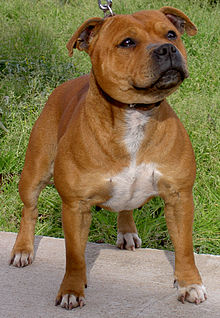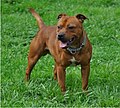This is an old revision of this page, as edited by Gareth Griffith-Jones (talk | contribs) at 08:37, 20 May 2018 (Correcting link). The present address (URL) is a permanent link to this revision, which may differ significantly from the current revision.
Revision as of 08:37, 20 May 2018 by Gareth Griffith-Jones (talk | contribs) (Correcting link)(diff) ← Previous revision | Latest revision (diff) | Newer revision → (diff)Dog breed
| Staffordshire Bull Terrier | ||||||||||||||||||||||
|---|---|---|---|---|---|---|---|---|---|---|---|---|---|---|---|---|---|---|---|---|---|---|
 | ||||||||||||||||||||||
| Common nicknames |
| |||||||||||||||||||||
| Origin | England | |||||||||||||||||||||
| ||||||||||||||||||||||
| ||||||||||||||||||||||
| Dog (domestic dog) | ||||||||||||||||||||||
The Staffordshire Bull Terrier is a medium-sized, short-coated breed of dog of English lineage and may be considered to be within the bull and terrier type.
History
Before the 19th century, blood sports such as bull baiting, bear baiting and cock fighting were common. At the cattle market, dogs were set upon bulls, purportedly towards tenderising the meat but actually to provide entertainment for the crowd. Blood sport with bears and other animals was organised as entertainment.
The early bull and terrier types were bred for the characteristic known as gameness, with the pitting of dogs against bear or bull; testing the strength and skill of the dogs. Landrace working dogs crossbred with bulldogs provided the ancestral foundation stock for the Staffordshire Bull Terrier. These bloodsports were officially eliminated in 1835 as Britain began to introduce animal welfare laws. Dog fighting involved gambling; dogs were released into a pit, and the last dog still fighting or surviving was recognised the winner. A dog fighting contest was cheaper to organise and easier to conceal from the law.
The modern breed is one that has a temperament suitable as a companion dog. It is a dog worthy to show and was accepted by The Kennel Club as the Staffordshire Bull Terrier on 25 May 1935. The Staffordshire Bull Terrier Club was formed in June 1935. It is unusual for a breed to be recognised without a club in existence first, and even more unusual for there not to have been a breed standard in place. A standard was not drawn up until June 1935 at the Old Cross Guns, a Black Country pub in Cradley Heath where 30 Stafford enthusiasts gathered and devised the standard and elected the club's first secretary, Joseph Dunn, a well-known figure connected with the breed.
Challenge certificates were awarded to the breed in 1938, and the first champions were Ch. Gentleman Jim (bred by Joseph Dunn) and Ch. Lady Eve (owned by Joseph Dunn), both taking titles in 1939. The breed was recognised in the U.S. by the American Kennel Club in 1975.
Appearance
The Staffordshire Bull Terrier is a medium-sized, stocky, and very muscular dog, with a similar appearance to the much larger American Staffordshire Terrier and American Pit Bull Terrier. The coat is smooth and clings tightly to the body giving the dog a streamlined appearance. This dog has a broad, wedge-shaped head (male considerably more so than female), defined occipital muscles, a relatively short fore-face, dark round eyes and a wide mouth with a clean scissor-like bite (the top incisors slightly overlap the bottom incisors). The ears are small. The cheek muscles are very pronounced. The lips show no looseness. The teeth form a scissor bite. The head tapers down to a strong well-muscled neck and shoulders placed on squarely spaced forelimbs. They are tucked up into their loins and the last 1–2 ribs of the rib-cage are usually visible. The tail resembles an old fashioned pump handle. The hind quarters are well-muscled.
They are coloured brindle, black, red, fawn, blue, white, or any blending of these colours with white. White with any other colour broken up over the body is known as pied. Liver-coloured, black and tan dogs can occur but are not desired, and it is advised not to breed from either as well as those with light eyes. The coat is smooth and clings tightly to the body giving the dog a streamlined appearance.
The dogs stand 36 to 41 cm (14 to 16 in) at the withers and weigh 13 to 17 kg (29 to 37 lb) for males; females are 11 to 15.4 kg (24 to 34 lb).
Temperament
Due to its breeding and history, common traits exist throughout; the Staffordshire Bull Terrier is known for its character of fearlessness and toughness. This, coupled with its affectionate nature, its off-duty quietness and trustworthy stability, make it a foremost all-purpose dog.
The breed is naturally muscular and may appear intimidating. Staffordshire Bull Terrier puppies are very easy to house train. They are friendly, enthusiastic and usually extremely affectionate. Staffordshires are notably adaptable in terms of changing home or even owners; this may make them vulnerable to dognapping.
RSPCA chief vet Mark Evans said: "Staffies have had a terrible press, but this is not of their own making–in fact they're wonderful dogs. If people think that Staffies have problems, they're looking at the wrong end of the dog lead! When well cared for and properly trained they can make brilliant companions. Our experience suggests that problems occur when bad owners exploit the Staffie's desire to please by training them to show aggression."
Breed-specific legislation
Main articles: Breed-specific legislation and Pit bullThe Staffordshire Bull Terrier is subject to breed-specific legislation in various countries, which ban members of the Bull and Terrier family.
Health
Staffordshire Bull Terriers are known to be prone to hereditary cataracts and L-2-hydroxyglutaric aciduria—a metabolic disorder resulting in behavioural changes and dementia-like symptoms—both of which are detectable by DNA tests.
Distichiasis (commonly known as “double eyelash”) and persistent hyperplastic primary vitreous—a condition whereby the blood supply to the ocular lens fails to regress and fibrovascular tissue forms, causing hazy vision—both of which are checked by way of an ocular examination throughout the life of a breeding stud or brood-bitch to minimise the transfer and spread of these conditions.
The breed is known to be at a higher risk from mastocytoma (mast cell tumours) than the general population of dogs. A UK Kennel Club survey puts the median lifespan at 12.75 years. UK vet clinic data puts the median at 10.7 years.
See also
- American Staffordshire Terrier
- American Pit Bull Terrier
- Breed-specific legislation
- Blue Paul Terrier
- Pit bull
- Rat-baiting
- Jock of the Bushveld
- Watchman (Regimental Mascot)
References
- https://www.doglistener.co.uk/choosing/staffie.shtml
- http://www.safe-and-sound.org/The-staffie
- "Frequently Asked Questions". Pit Bull Rescue Central. Retrieved 15 August 2017.
- "Breed Information Centre – Staffordshire Bull Terrier". The Kennel Club. Retrieved 13 November 2014.
- Merriam-Webster. "Pit bull". Retrieved 26 October 2015.
a dog... of any of several breeds... that was developed and is now often trained for fighting and is noted for strength and stamina
- Dias v. City & County of Denver, 567 F.3d 1169, 1173 (10th Cir. Colo. 2009). http://definitions.uslegal.com/p/pit-bull/. Retrieved 26 October 2015.
A "pit bull" is defined as any dog that is an American Pit Bull Terrier, American Staffordshire Terrier, Staffordshire Bull Terrier, or any dog displaying the majority of physical traits of any one (1) or more of the above breeds
{{cite web}}: Missing or empty|title=(help)CS1 maint: multiple names: authors list (link) CS1 maint: numeric names: authors list (link) - ASPCA. "The Truth About Pit Bulls". Retrieved 26 October 2015.
The term 'pit bull' is often misunderstood, because it does not apply to just one breed of dog.
- Foster, Ken (2012). I'm a Good Dog: Pit Bulls, America's Most Beautiful (and Misunderstood) Dog. New York: Viking Studio.
For some lovers of the American pit bull terrier... 'pit bull' is embraced as shorthand for their breed. However, fans of the American Staffordshire terrier and English Staffordshire terrier are usually quick to tell you that their breeds are not pit bulls. To the general public, all three dogs are perceived as pit bulls, along with variations of the American bulldog, bull terriers, bullmastiffs, and even boxers, as well as mixes of these breeds.
- ^ American Kennel Club. "AKC Staffordshire Bull Terrier Breed History". www.akc.org. Retrieved 29 July 2008.
- "American Kennel Club – Staffordshire Bull Terrier". www.akc.org. Retrieved 16 February 2010.
- "Staffordshire Bull Terrier Breed Standard". The Kennel Club. September 2000. Retrieved 17 May 2013.
- Nicholas, Anna Katherine (2001). Staffordshire Bull Terriers. TFH Publications. p. 30. ISBN 0-7938-2335-8.
- "Breed information centre, Staffordshire Bull Terrier". The Kennel Club. Retrieved 13 September 2017.
- "Staffordshire Bull Terrier" (PDF). FCI. p. 2. Retrieved 13 September 2017.
- "Breed Standard – Staffordshire Bull Terrier – Terrier". NZKC. Retrieved 13 November 2014.
- American Staffordshire Terrier, Meet the Breeds, American Kennel Club (AKC)
- Lee, Clare (1 January 1998). The Pet Owner's Guide to the Staffordshire Bull Terrier. Ringpress Books Ltd. ISBN 978-1-86054-082-0.
{{cite book}}: Cite has empty unknown parameter:|coauthors=(help) - "K9 Magazine Article". Dogmagazine.net. Retrieved 26 April 2011.
- Campbell, Dana (July–August 2009). "Pit Bull Bans: The State of Breed–Specific Legislation". GP-Solo. 26 (5). American Bar Association. Retrieved 30 July 2009.
The American Kennel Club (AKC), the nation's largest dog–breed registry, does not recognize a 'pit bull' breed per se. The AKC–recognized breeds most commonly included within current BSL are Bull Terriers, American Staffordshire Terriers, and Staffordshire Bull Terriers
- "Currently Available DNA Tests". Caninegeneticdiseases.net. Retrieved 25 December 2008.
- "Percentage of deaths due to cancer suffered by dogs of different breeds compared with the percentage of the breed in the survey population (adapted from Michell, 1999)". Vetstreamcanis.co.uk. Retrieved 25 December 2008.
- "Individual Breed Results for Purebred Dog Health Survey".
- O’Neill, D. G.; Church, D. B.; McGreevy, P. D.; Thomson, P. C.; Brodbelt, D. C. (2013). "Longevity and mortality of owned dogs in England". The Veterinary Journal. 198: 638–43. doi:10.1016/j.tvjl.2013.09.020. PMID 24206631.
External links
![]() Media related to Staffordshire Bull Terrier at Wikimedia Commons
Media related to Staffordshire Bull Terrier at Wikimedia Commons
| Dogs originating in the United Kingdom | |||||||
|---|---|---|---|---|---|---|---|
| Hounds | |||||||
| Gun dogs | |||||||
| Terriers |
| ||||||
| Herding dogs | |||||||
| Other | |||||||
| Extinct |
| ||||||
| |||||||
Categories:











